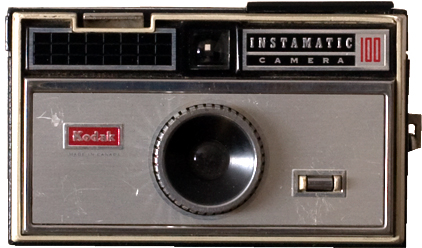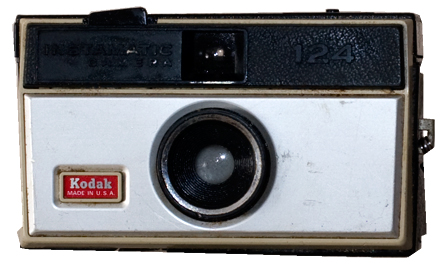
Approx. dates of manufacture: 1963-1966 (model 100); 1968-1971 (model 124)
Approx. original price: $15.95
Approx. street value: Nothing beyond scrap metal value.
The third camera I ever bought was from Veteran's Thrift Shop in Garden Grove (no longer there), for 60¢ in 1973, and used for my first darkroom work in a summer-school course in 1974: the Instamatic 124 (bottom of page). I got this model 100 in a box of junk I bought recently that included the Zenit EM and a trove of accessories. They're mostly the same camera. The only serious difference is that the 100 takes AG-1 flash bulbs: the little button next to the lens releases a pop-up reflector and socket; the 124 has a Magicube socket on the top, so no pop-up device was needed.
Kodak tried to kill off 35mm several times, and in the 1960s it tried with what was really a pretty good idea—sell 35mm-sized film in a plastic cartridge that could be dropped into a camera. It solved all kinds of problems: it was next to impossible to misload it (but we've all fouled up film in 35mm cameras), if you accidentally popped the back open you only lost one image (but you could ruin half a roll doing that on a 35mm camera), they almost never jammed. In many ways they were great.
So for a decade they sold big. By the time I started taking pictures, they were still popular but people were migrating to the similar but smaller 110 format; but as I got older, they lost ground to the better 35mm point-n-shoots that were coming out and to Poloroids. By the early 80s they were pretty much dead.
Part of the reason was that almost nobody made a good camera to use the format. Only Rollei made a high-end system camera that took 126, and it wasn't enough to convince people that 126 was a "serious" format. Most cameras for the format were also simple point-n-shoots, like the Voigtländer Bessy AS.
 Instead you got a boatload of these things. This one, the 100, was typical of the early cameras: fixed focus, no
controls whatsoever except a shutter button. This one has a photocell meter (probably just to determine whether you needed flash or not), and
there's a pop-up reflector for peanut flash bulbs. The viewfinder is the typical tiny bombsite that Kodak loved,
even though it looked cheap and awful.
Instead you got a boatload of these things. This one, the 100, was typical of the early cameras: fixed focus, no
controls whatsoever except a shutter button. This one has a photocell meter (probably just to determine whether you needed flash or not), and
there's a pop-up reflector for peanut flash bulbs. The viewfinder is the typical tiny bombsite that Kodak loved,
even though it looked cheap and awful.
A Wikipedia article says this is the first US model (the model 50 in the UK a few months earlier). Unlike the later offerings, this was mostly metal (and it feels it), and it lacks the Magicube flash socket on later models. I like the metal feel much better than the chintzy plastic used later.
These cameras are no longer in my collection.

